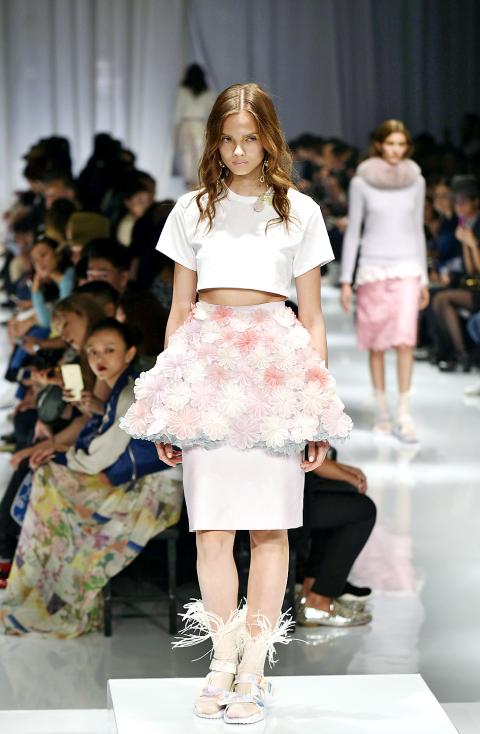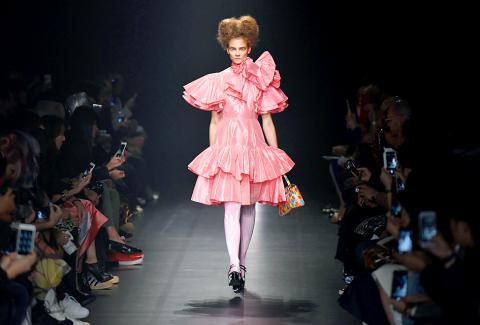Bubblegum-pink hearts, tulle skirts and polka dots: the unapologetically feminine fashion that originated in Tokyo has exploded in the West with Hollywood celebrities earning brickbats for adopting the “girly” style.
The hugely popular kawaii (cute) look, which blends traditional Japanese concepts of purity and innocence with the doll-like aesthetic embodied by Hello Kitty and other beloved mascots, traces its roots to the late 1970s.
While it made significant inroads into Southeast Asia throughout the 1990s, Western fashion sentiments had remained largely impervious to — and even somewhat sneering about — its cutesy charms.

Photo: EPA
The vivid aesthetic occupies pride of place in Japanese pop culture, particularly in the visual stylings of 22-year-old kawaii entertainer, Kyary Pamyu Pamyu. However, it has begun winning fans further afield, including musicians like Katy Perry, Lady Gaga and Nicki Minaj.
A watered-down version of the style has made inroads into US pop culture, embodied by Disney star Ariana Grande and actress Zooey Deschanel in her leading role as a quirky schoolteacher in the TV show New Girl.
Miley Cyrus’ current psychedelic, hyper-sexualized look also contains plenty of kawaii inspiration. As the glitterati gathered in Tokyo for fashion week, Japanese designers showcased plenty of outfits with a cute twist. Designer Keita Maruyama dressed models in feather-topped ankle socks and suits embellished with pompoms, while offbeat label Dresscamp opted for pink taffeta capes and sequinned tulle petticoats.

Photo: AFP
Tokyo-based blogger and TV host Misha Janette says Japan also experienced a new surge in kawaii culture after the 2011 earthquake-tsunami disaster.
“I think people needed the infusion of fun, which is why we saw these colorful fashion statements emerge,” she said.
However, the sight of women wearing items usually aimed at children — from headbands embellished with cat-ears to frothy skirts and tops showcasing strawberry cupcakes or cartoon characters — have aroused the ire of feminist commentators based in the West.
“To make a woman look like a child is to make her unthreatening, helpless and worthy of condescension. When women dress like children, they encourage this attitude,” wrote Hadley Freeman, columnist for the Guardian newspaper.
Industry insiders dismiss such concerns.
“Just because a woman dresses like a doll doesn’t mean she wants to be treated like a doll,” said Janette, host of popular TV show Kawaii International.
Furthermore, in a country that values conformity, fashion offers a rare window for self-expression, Janette added.
Tokyo’s streets are famous for the proliferation of fashion tribes ranging from gothic schoolgirls to pastel princesses, with young men and women seizing the opportunity to explore subcultures and stand out from the crowd.
“Every time a new aesthetic emerges here, it really is about girls dressing for themselves as opposed to girls dressing to get a date,” said Tiffany Godoy, author and editor in chief of the bilingual The Reality Show Magazine.
In Tokyo’s trendy Harajuku neighborhood, where US clothing chain stores compete with tiny boutiques crammed with stuffed unicorns, glitter-covered ballet flats and heart-shaped bags, 26-year-old singer Momo Ninomiya said she was on the lookout for a kawaii accessory.
“This kind of style is so girly... I love cute things, that’s why I enjoy dressing like this,” Ninomiya said, referring to her frilly ankle socks, headband and 1950’s-style skirt printed with perfume bottles and flower bouquets.
“Some of my friends say they are embarrassed to walk with me when I am dressed like this ... [but] I don’t think there’s anything wrong with the way I dress,” she said.
According to fashion editor Godoy, the criticism leveled at young women like Ninomiya represents a dated take on feminism.
“It’s such an old-fashioned way of looking at things. The way these girls dress, it’s about being playful and wearing clothes that make them happy,” Godoy said.
And like any subculture, “it makes people uncomfortable because it’s not a traditional way to dress,” she said.

Six Taiwanese companies, including contract chipmaker Taiwan Semiconductor Manufacturing Co. (TSMC), made the 2025 Fortune Global 500 list of the world’s largest firms by revenue. In a report published by New York-based Fortune magazine on Tuesday, Hon Hai Precision Industry Co. (better known as Foxconn) ranked highest among Taiwanese firms, placing 28th with revenue of US$213.69 billion. Up 60 spots from last year, TSMC rose 60 places to reach No. 126 with US$90.16 billion in revenue, followed by Quanta Computer Inc. at 348th, Pegatron Corp. at 461st, CPC Corp., Taiwan at 494th and Wistron Corp. at 496th. According to Fortune, the world’s

NEW PRODUCTS: MediaTek plans to roll out new products this quarter, including a flagship mobile phone chip and a GB10 chip that it is codeveloping with Nvidia Corp MediaTek Inc (聯發科) yesterday projected that revenue this quarter would dip by 7 to 13 percent to between NT$130.1 billion and NT$140 billion (US$4.38 billion and US$4.71 billion), compared with NT$150.37 billion last quarter, which it attributed to subdued front-loading demand and unfavorable foreign exchange rates. The Hsinchu-based chip designer said that the forecast factored in the negative effects of an estimated 6 percent appreciation of the New Taiwan dollar against the greenback. “As some demand has been pulled into the first half of the year and resulted in a different quarterly pattern, we expect the third quarter revenue to decline sequentially,”

WEAKER ACTIVITY: The sharpest deterioration was seen in the electronics and optical components sector, with the production index falling 13.2 points to 44.5 Taiwan’s manufacturing sector last month contracted for a second consecutive month, with the purchasing managers’ index (PMI) slipping to 48, reflecting ongoing caution over trade uncertainties, the Chung-Hua Institution for Economic Research (CIER, 中華經濟研究院) said yesterday. The decline reflects growing caution among companies amid uncertainty surrounding US tariffs, semiconductor duties and automotive import levies, and it is also likely linked to fading front-loading activity, CIER president Lien Hsien-ming (連賢明) said. “Some clients have started shifting orders to Southeast Asian countries where tariff regimes are already clear,” Lien told a news conference. Firms across the supply chain are also lowering stock levels to mitigate

DIVERSIFYING: Taiwanese investors are reassessing their preference for US dollar assets and moving toward Europe amid a global shift away from the greenback Taiwanese investors are reassessing their long-held preference for US-dollar assets, shifting their bets to Europe in the latest move by global investors away from the greenback. Taiwanese funds holding European assets have seen an influx of investments recently, pushing their combined value to NT$13.7 billion (US$461 million) as of the end of last month, the highest since 2019, according to data compiled by Bloomberg. Over the first half of this year, Taiwanese investors have also poured NT$14.1 billion into Europe-focused funds based overseas, bringing total assets up to NT$134.8 billion, according to data from the Securities Investment Trust and Consulting Association (SITCA),